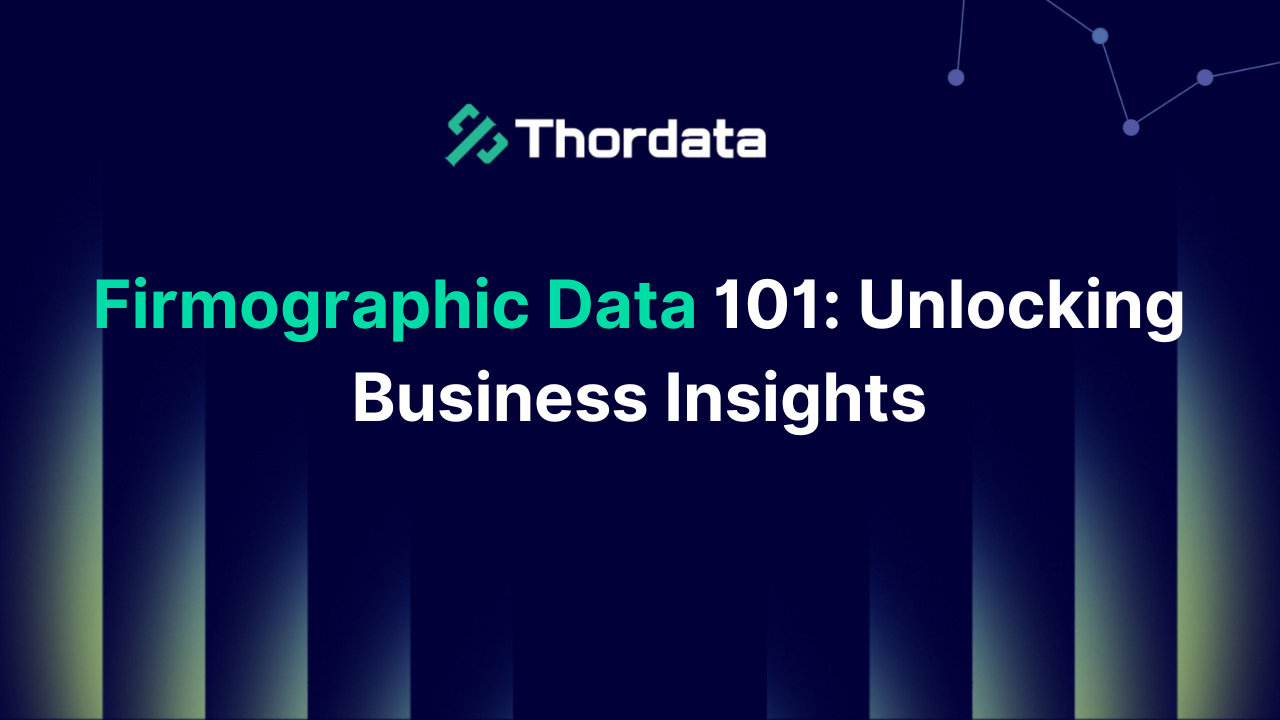Firmographic Data 101: Unlocking Business Insights


In a highly competitive business environment, every company strives to secure a position in the market . And every company strives to make precise strategic decisions in their target markets.
However, only accurate and comprehensive data can help a business understand its operational status. It helps company gain insights into market trends, and seize growth opportunities. In this process, firmographic data plays a crucial role.
Next, we will explore in detail what firmographics are, its specific examples, and why it is so important. Mastering this data, companies can make more accurate strategic decisions. To achieve business goals, and stand out in the everchanging market.
What is Firmographic Data?
In the business environment, firmographic data is important for company operations and decision-making. It reflects various aspects of a company’s information and current situation. And covers financial status, market share, employee composition, customer profiles and business lifecycle.
This data not only helps companies understand their own operational conditions. But also help analyze market trends and make strategic decisions.
With this data, businesses can deeply analyze both internal operations and the external market environment. Thereby creating more effective strategies, reducing risks, and enhancing overall competitiveness. It also help they to attract potential customers.
Examples of Firmographic Data
Firmographics can help company operations in various functional aspects departments. We can divide firmographics into the following categories:
1. Financial Data
Revenue and Profit:
Key financial metrics such as annual revenue, net profit, and gross margin.
Balance Sheet:
A list of the company’s assets and liabilities, helping to analyze the company’s financial health.
Cash Flow:
The cash flow generated by the company’s operations, reflecting its ability to manage capital.
2. Market Data
Market Share:
The company’s market share within its industry or market.
Competitor Analysis:
Comparison with competitors to understand the company’s strengths, weaknesses, and gaps.
Customer Data:
Customer demographics, purchasing behaviors, and demand trends.
3. Organizational Size
Employee Number:
The number of employees is a key indicator of company size.
Small Business:
Fewer than 50 employees, typically startups, local businesses, or familyowned enterprises. Their market focus is usually limited, and resources are often constrained.
Medium-sized Enterprise:
Medium-sized Enterprise has between 50 and 500 employees. These businesses are often in their growth phase.
Large Enterprise:
More than 500 employees, including multinational corporations and industry leaders. These companies often operate across various regions and markets. They have substantial resources and capital, and lead the market.
4. Company Structure and Ownership
Shareholder Structure:
The shareholders of the company help to understand the control and making decision structure.
Organizational Structure:
The setup of departments within the company and the hierarchy of management.
5. Geographical Location
Headquarters and Branches:
The geographic locations of the company’s headquarters and its branches, helping to analyze market coverage .
This data helps companies understand their position in the market. Such as profitability, internal resource allocation and so on. And the external competitive environment they face.
Why is Firmographic Data Important?
Firmographic data is crucial for business operations. As it reveals the current state of a company’s performance and can guide future growth strategies. Here are several key reasons why it matters:
1. Market Segmentation
By analyzing firmographic data, businesses can more identify different segments within the market. This helps companies develop precise product, pricing, and marketing strategies. That attracts target customers and increase market share.
2. Developing Personalized Sales Strategies
Firmographic data reveals customer purchasing behaviors, preferences, and needs. This information helps companies develop more personalized sales policies, increasing conversion rates.
3. Competitive Analysis
Firmographic data helps businesses understand competitors’ performance, strengths, weaknesses, and market share. By comparing with competitors, companies can assess their position in the market. And adjust their product, service, or marketing strategies to gain an edge.
4. Risk Assessment
Businesses can identify potential risks. By analyzing the company’s financial health, debt structure, and market performance. For example, if a company discovers that its cash flow is tight, it may need to take measures to improve capital efficiency.
5. Strategic Decision Support
Data is the foundation for strategic decisions. By regularly analyzing firmographics, management can better understand the company’s position and market trends. Thus making more confident strategic decisions. Such as entering new markets, launching new products, or adjusting business direction.
Key Firmographics Questions
What is the official name of the company?
What is the company’s business scope?
How large is the company?
What is the shareholder structure and organizational chart?
What is the company’s financial status and operational data?
What is the capital structure?
How many employees does the company have?
What is the employee satisfaction level?
What are the company’s recruitment needs and the number of employees being hired?
What is the company’s current market share and industry position?
Who are the company’s competitors?
Methods and Tools for Collecting Firmographic Data
We can use thirdparty data platforms to collect firmographic data. we can also selfcollect data based on specific needs via automated tools.
Thirdparty Data Platforms:
Professional data collection platforms such as Crunchbase, S&P Capital IQ, and others can provide extensive data about companies, industries, and markets.
If thirdparty data platforms do not meet your needs, you can collect data from the following sources:
1. Company Website:
The official company website is the most direct way to gather information. Key sections such as “About Us,” product information, news, and job postings offer insights into company history, culture, products, positions, and employee benefits.
2. Government Databases and Regulatory Agencies:
You can consult publicly available government and regulatory agency databases. For example, SEC EDGAR provides access to company filings submitted to the U.S. Securities and Exchange Commission.
3. Data Platforms for Industry Analyzing:
Platforms like Statista offer statistical data, research, and industry reports. They are ideal for acquiring company data in specific industries. Gartner is great for insights into the tech and IT sectors.
4. Social Media and Professional Networks:
Following company social media accounts on platforms like Facebook, Twitter, and LinkedIn can provide realtime updates on news and employee data.
How Thordata Helps with Data Collection
1. Solving Regional Information Gaps
Thordata has global coverage, effectively bridging information gaps and uncovering hidden data.
2. Automated Data Collection
By utilizing Thordata’s proxy IP services alongside automated data scraping tools. You can avoid data collection being blocked and improve data gathering efficiency.
3. Avoiding Information Leaks and Gaining a Market Advantage
Using Thordata with antidetection browsers ensures anonymous access. Which helps prevent IP detection, maintain privacy, and shield you from competitors gaining a market edge.
Conclusion
Firmographic data is a valuable resource for companies. Which help them understand the market, optimize operations, and enhance competitiveness.
By systematically collecting, organizing, and analyzing this data, businesses can make better decisions and improve operational effectiveness. Whether gathering data internally or using thirdparty platforms and automation tool. The right collection methods and tools ensure accurate, timely, and highquality data.
Frequently asked questions
What is the difference between demographics and firmographics?
Demographic data describes individuals (e.g., age, gender, income), mainly used in consumer markets like marketing and social research.
Firmographic data describes companies (e.g., industry, size, revenue), primarily used in B2B environments like sales, market segmentation, and business analysis.
What are some firmographic data providers?
Crunchbase provides detailed data on global companies, startups, venture capital firms, and investors, mainly focused on the tech industry.
S&P Capital IQ offers financial data, risk assessments, and analytical tools on global companies, markets, and industries.
ZoomInfo provides comprehensive data on companies, including size, industry, contact information, technology use, and management.
What are the criteria for classifying small, medium, and large enterprises?
People classify enterprises based on the number of employees or assets.
Small enterprise has Less than 50 employees.
Mediumsized enterprise the number of employees between 50 and 500 .
Large enterprise has more than 500 employees.
People tend to divide assets to fixed and current assets. Large enterprises typically have more fixed assets like factories and equipment.
About the author
Clara is a passionate content manager with a strong interest and enthusiasm for information technology and the internet industry. She approaches her work with optimism and positivity, excelling at transforming complex technical concepts into clear, engaging, and accessible articles that help more people understand how technology is shaping the world.
The thordata Blog offers all its content in its original form and solely for informational intent. We do not offer any guarantees regarding the information found on the thordata Blog or any external sites that it may direct you to. It is essential that you seek legal counsel and thoroughly examine the specific terms of service of any website before engaging in any scraping endeavors, or obtain a scraping permit if required.